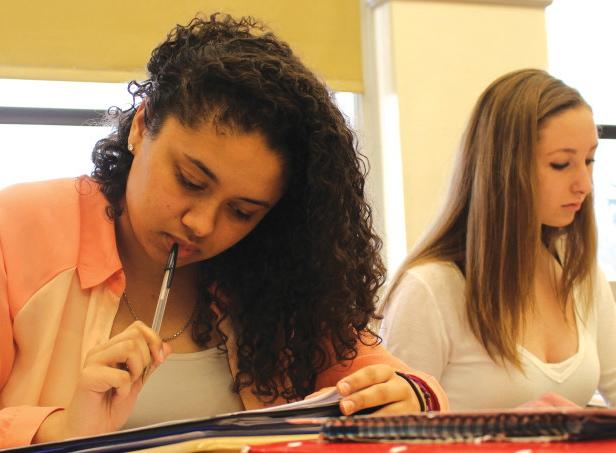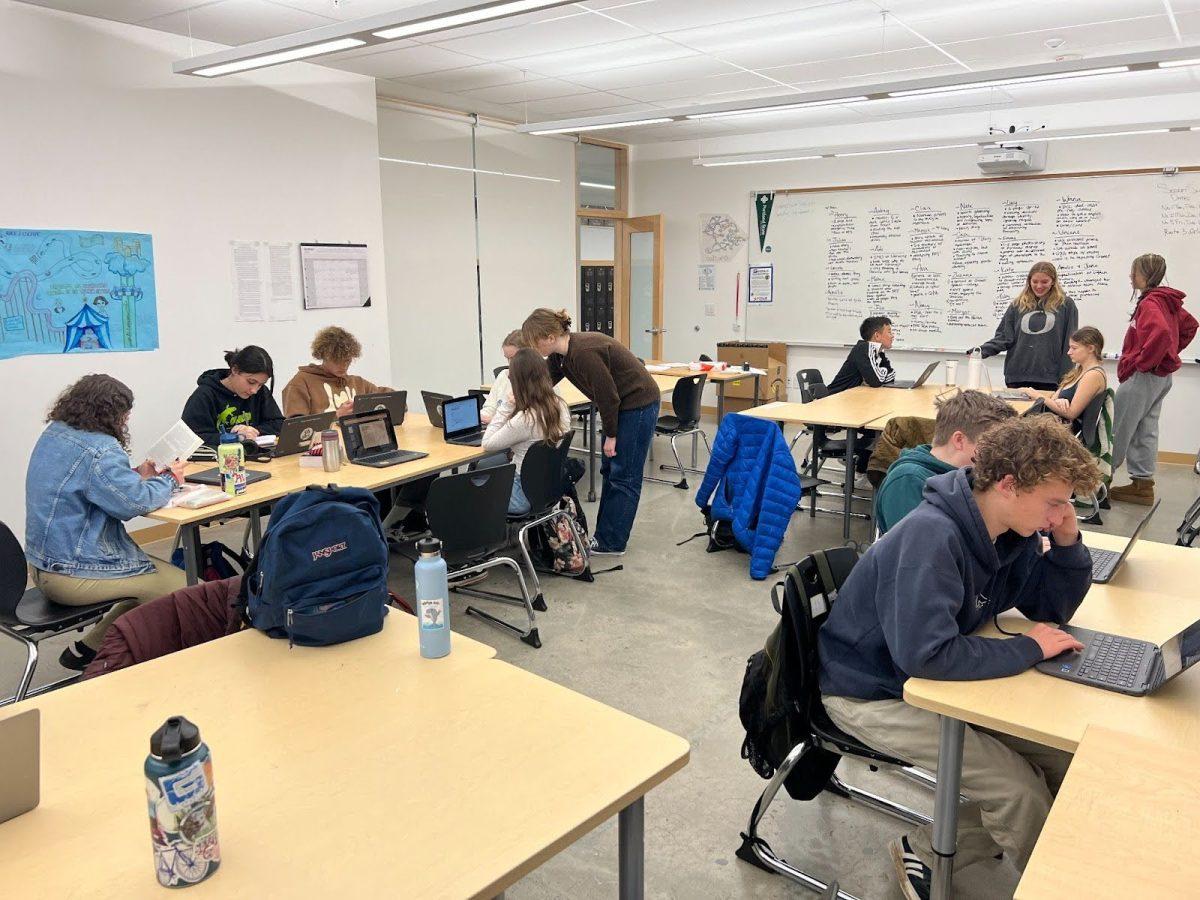When Grant High School junior Brianna Hayes walks into her AP English classroom, she doesn’t start by looking for the ways she’s different from the other students. “I just come in and I’m like everybody else,” Hayes explains.
But she also knows that’s not always how others see her. “I know everywhere I go…I’m going to be judged and I’m going to leave an impression of how someone of African-American race is,” says Hayes, 17.
Hayes’ experience isn’t unique for students of color at Grant. Walk into most advanced classes at the school and you’ll find a room dominated by white students, with racial minorities few and far between.
Students in advanced or college-level classes have to deal with the more challenging course loads. But some minority students like Hayes feel they have more on their plates: serving as a representative for their race. “I have to do more,” Hayes says, “because that’s the only way I’ll break a stereotype that is against me.”
“Some of it is racism and it is manifested in low teacher expectations.” – Edward Olivos
Senior Taylor Hall-Debnam, who is black, has also experienced difficulties in advanced classes. “Even though the class had like 35 students, sometimes I felt like I was the only one in the room,” says the 18-year-old Hall-Debnam. “I felt like I didn’t really have anyone to connect with.”
The numbers show there’s something wrong. Students of color make up a third of the Grant population, but stand as only one-fifth of those taking Advanced Placement classes. When it comes to the college-level courses, minorities make up slightly more than a quarter. What does this mean for students? Why is there a gap? And what’s being done to address the issue?
According to experts, it begins a lot earlier than high school. “To close this gap in high school is too late,” says Edward Olivos, associate professor in the Department of Education Studies at the University of Oregon. “It’s got to be done in elementary school and has to go through middle and high school.”
Olivos says there are many reasons behind the gap. “One can be that students of color traditionally attend lower performing elementary and middle schools,” he says, so they are not as well prepared for higher-level courses in high school.
“Some of it is racism and it is manifested in low teacher expectations…and the mentality that these kids cannot do better or try harder, and that teachers should teach them easy content,” says Olivos.
Grant’s upper-level classes can offer an interesting look into the world of education and race. For example, two-thirds of Grant’s junior and senior classes – the students who are typically allowed to take AP or college-level classes – are comprised of white students; African-American students are the second largest racial group, making up 15 percent. Yet, white students fill 80 percent of AP classroom slots and African-Americans make up less than 4 percent.
Some classes attract more students of color than others. AP English boasts greater diversity than AP Physics, with total percentage of 23 percent students of color versus 15 percent. AP Calculus AB is one of the most diverse AP classes, with almost a quarter of students – 22 of 96 – being racial minorities.
But the number drops sharply when you move to AP Calculus BC – a second year class, in which only two of 35 students identify as non-white.
Two-thirds of Grant’s junior and senior body is white.
“I do believe systemic racism plays a big role,” says Grant history teacher Marta Repollet. She notes the division of students starts at a young age when teachers give up on low-achievers instead of focusing on the kids they see struggling.
“It’s the way kids of color have been channeled since elementary school,” says Repollet, who teaches a class called Living in the USA that focuses on the experiences of racial groups. “Eventually, that kid starts to believe, ‘I’m not good enough because I’m academic probation.’ And then they start to think, ‘There must be something wrong with me, and therefore, I’m not going to take that AP class. I’m too dumb.’”
Grant and the Portland Public Schools district have waged a campaign for years to close the achievement gap between white and minority students. Programs are in place to support the students who often fall through the cracks and encourage minorities to excel.
But as administrators and some teachers fight that battle, there’s a backlash effect on high-achieving students of color. They can feel isolated, singled out, and that – because of other people’s stereotypes – they have to carry a larger load than just the academics.
Take the case of Hayes. Born and raised in North Portland, Hayes says she grew up in a community where everyone knew each other. Her family was close and there was always music playing in the house.
She went to the academically strict Holy Redeemer Catholic School from kindergarten through eighth grade. “It was like a family,” Hayes says today, adding that for her, school was sometimes an escape. “No matter what’s going on in your home life, when we went to school, it didn’t matter.”
Hayes recalls the student population at Holy Redeemer was fairly diverse, but she didn’t really understand the significance of her own racial background until high school. That’s when she started paying more attention to race. Still, junior year it took Hayes a few days to really notice the lack of students of color in her advanced classes. “I kind of expected it,” she says.
It hasn’t stopped Hayes from excelling. She has straight A’s, plans to go to college, and is considering a career in business, medicine or even teaching. She says she gets her drive from her dad. He agrees that she’s a hard-working student. “Brianna is very dedicated to her studies,” says Leonard Hayes. “The sky’s the limit for her.”
But though Hayes is doing well academically, she says there’s an added burden as a student of color taking advanced classes. You represent more than just yourself, says Hayes.
Portland State University assistant professor of sociology Hyeyoung Woo explains that stereotypes of underperforming students of color can play a role in the classroom. “Teachers might unintentionally express their expectations differently to white students from non-white students,” says Woo, noting a behavior that the other students in the room might adopt.
“Whenever you have kids of color that you see are doing well academically, you try to encourage them to challenge themselves and not just settle on getting by.” – Diallo Lewis
When students of color are given lower expectations, they tend to meet these rather than exceed, in a pattern called a “self-fulfilling prophecy.” On the other hand, says Woo, stereotypes can also put pressure on students to excel, like the stereotype that all Asian students are good at math. An Asian student recognizing this expectation can perform more poorly than their true ability, simply because of the stress of being under pressure.
All of this can discourage students of color from challenging themselves at school.
Grant security guard Troy Berry remembers his own experiences with the education system starting in his hometown of Galesburg, Illinois. Getting bussed out of his primarily African-American neighborhood to a predominately white school was one of the best things that ever happened to him, he says.
“Whenever you are in a privileged environment, obviously one important thing is education. So when I went out there, education was good,” remembers Berry. “I learned study skills, time management skills, and I learned how to discipline myself.”
Berry moved to Portland in the middle of his ninth grade year. An athlete throughout his time at Benson High School, Berry says school was important to him. Though he wasn’t a straight-A student, he tried to keep up with his peers and earn passing grades at the least.
Today, as he chats with students in the hallways of Grant, Berry makes sure to mention the importance of education. He thinks responsibility needs to be passed around.
“Oftentimes, we can get ourselves in a situation where we don’t really give ourselves the credit and the confidence,” says Berry. “I see a lot of talent around here and a lot of individuals who are smart, and they are not challenging themselves and they are not being challenged.”
Diallo Lewis, Grant’s co-athletic director and a former counselor at the school, says he tries to reach out to all students about their education. “Getting some kids to understand their potential and what it means to maximize who they are, and be their best,” he says, is one of his top challenges when trying to encourage students of racial minorities to take AP and advanced classes. He feels it’s important to keep an eye out for strong performers who need the extra push to try an advanced class.
“Whenever you have kids of color that you see are doing well academically, you try to encourage them to challenge themselves and not just settle on getting by,” says Lewis, who is one of a handful of black staff members at Grant. “I think we have some amazing young kids of color who are here in this building, and too often kids come in not understanding the possibilities that they could become.”
He sees the need for faculty and adults to help students understand who they can become, and what potential options are after high school.
According to Vice Principal Kristyn Westphal, the gap is a serious issue. “We want to see basically the same representation of students at least within AP classes as we have within the school,” Westphal explains.
But the diversity of Grant’s student population is shifting. Westphal says the gentrification – the displacement of poorer residents by more wealthy buyers, which corresponds with the shifting of African-American families out toward East Multnomah County and the growth of whites in North and Northeast Portland – is partly to blame.
“A few years ago,” Westphal says, “about 25 percent of the student body was African-American. Last year was 16 percent. This year, it’s 14.5 percent. So it’s decreasing significantly.”
Westphal adds that Grant also has biracial students, many of whom may identify as black, depending on how you ask the question. But these numbers are going down, as well.
Roberta Hunte is an assistant professor at Portland State University who teaches within the Black Studies, Conflict Resolution, and Women, Gender and Sexuality Studies departments. She explains that institutional racism lasts for a long time because eradicating it is a slow process of analyzing and revising traditional policies and practices.
“You’re going to go into this classroom and you’re going to be the only black person, the only Latino, the only Asian, but at the same time, make sure you work hard.” – Brianna Hayes
Grant is also severely lacking in teachers of color, which affects the whole student population, something Hunte says can also set things back. “Students need to see some teachers who look like them,” says Professor Hunte. “And white students need to see some teachers who look different from them. That needs to be the norm.”
Senior Luis Tzab grew up in North and Northeast Portland. He says there’s a difference in social class between his neighborhood and Grant. Tzab went to Jefferson for his first two years of high school and remembers a stark difference in the school’s diversity.
Unlike at Grant, people of color make up most of Jefferson’s student population. Coming to Grant, Tzab, 18, says he had to adjust to a “completely different learning environment” because, he says, Grant’s classes are harder in general.
Tzab guesses a lack of opportunity can affect students of color and their participation in advanced classes. That includes household support, he says. “I know a lot of people, a lot of minorities, who don’t have support from their parents,” he says. “That’s one thing my parents do: they actually push me and want me to do better than them in life and all that, and that’s a reason I took harder courses because I do want to go to college.”
“I felt like my classmates thought I was stupid and what I had to say didn’t matter.” – Brendan Fontaine
“We’re all here to learn. That’s really what it comes down to, from my perspective,” says Tzab.
In contrast, when Hayes encourages other students of color to take advanced classes, she’s frank about her viewpoint: “You’re going to feel uncomfortable,” she tells them. “You’re going to go into this classroom and you’re going to be the only black person, the only Latino, the only Asian, but at the same time, make sure you work hard.”
For Hayes, with her sights set on college, stepping out of her comfort zone is necessary. But it’s tough when she feels like others see her as a race rather than as an individual. “I definitely feel like sometimes I’m underestimated,” she says.
Brendan Fountaine, who is black, felt the same way. A 2012 Grant grad, he remembers being terrified in advanced classes. “I felt like my classmates thought I was stupid and what I had to say didn’t matter,” he recalls.
However, he stuck with it, and he came to realize he brought the value of a different perspective to his classes because of his different background. Fountaine grew up the youngest of five to a single mother in a poor neighborhood, he says. At Grant, he met people for whom going to college was a family tradition and an expectation.
An average AP class at Grant is 20 percent students of color, while an average dual-credit class is 28 percent.
As an upperclassman, Fountaine hadn’t planned on advanced classes, but he ended up taking them anyway. “Coach Lewis was my counselor and he wouldn’t let me sign up for a regular class. He made me sign up for AP,” recalls Fountaine. “He literally put it on my schedule.”
He remembers his mixed feelings about his experiences: “It was frustrating at times to be that underestimated,” Fountaine says, “and it was also satisfying to prove people wrong and prove the statistics wrong.”
Today, Fountaine is a sophomore majoring in computer science at Morehouse College, an all-male, historically black university in Atlanta. He was a recipient of the Gates Millennial Scholarship, a program that selects skilled students to obtain a “good-through-graduation” grant to any college or university of their choice.
Fountaine says part of the problem for young students of color today is a lack of the right kinds of example. “They might have idols who are basketball players and rappers,” he says. “But they don’t have figures that they can look and say, ‘Wow, this person went to school and is now successful.’ And I try to be that person, and be that role model, because I feel that it’s important.”
Grant special education teacher Margarett Peoples believes teachers need to go beyond simply inviting students to their classes. “The type of encouragement can’t just be, ‘Would you come and join my class?’” she says. “It needs to be more about, ‘You’re African-American and here’s how your heritage can connect to the class.’”
Peoples, who is black, is the supervisor of Grant’s Black Student Union, a club with fewer than a dozen regular members. She says the student-run club only discusses advanced classes if members choose to bring up the topic. However, she does recall that a couple members spoke with the administration about adding more diverse advanced classes.
“I think if we had more socially and culturally relevant classes then we would have students that were branching out more,” says Peoples, pointing out the dual-credit African-American Literature class as an example of a success.
The class is taught by Grant English teacher Russell Peterson, who is white. It’s an exception to Grant’s pattern of primarily white advanced classes. Half of its students are racial minorities, double the average amount of students of color in dual-credit classes. Some say it’s especially popular with students of color because it focuses on the history and significance of a racial minority group – something that is often passed over in traditional history classes.
The class, which offers Portland Community College credit, is one of nine dual-credit college level classes offered at Grant. These alternatives to AP attract a higher amount of students of color than AP classes: an average AP class is 20 percent students of color, while an average dual-credit class is 28 percent.
Westphal says there are a few plans in play to better the situation. “One thing is just helping the teachers to try and figure out how to build better relationships with students,” she says. “Because I think that’s a lot of it. You know if a teacher has had a student one year, and they can sort of coax them into an upper level class, that’s one good way to do it.”
Grant teachers also go through professional development to help grow their awareness of how their racial background influences their teaching. The dearth of teachers of color is not a quickly solved issue. But helping current staff understand the significance of race in the classroom is a step in the right direction.
“We do a better job than we used to,” says Westphal. “But I think there’s still a lot of room for growth.” ♦







































